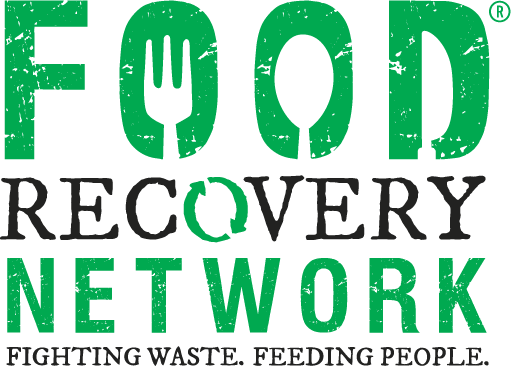In California, Chefs to End Hunger is making a massive difference in the fight to reduce food waste and combat hunger. As the Food Recovery Verified (FRV) VISTA, I know of the thousands of pounds recovered by FRV businesses who work with Chefs to End Hunger. FRV is a program of Food Recovery Network that helps food businesses all across the country form partnerships with hunger-fighting nonprofits in their communities. Chefs to End Hunger is one of many nonprofits that FRV works with to recover and donate food in California. According to Feeding America, the food insecurity rate in California is 11.7%. The hard work of both FRV businesses and Chefs to End Hunger is putting a dent in this food insecurity rate.
Chefs at Bon Appétit at SAP are showing their pride for Chefs to End Hunger by posing with a hunger kit.
Chefs to End Hunger uses a unique, yet simple system to fight food insecurity in their communities. They have incredible success with food recovery in the communities they serve thanks to the assistance of LA & SF Specialty (LAS), the company that founded Chefs to End Hunger. LAS is a food service distributor that delivers perishable foods to businesses in Los Angeles, San Francisco, and the surrounding areas. Chefs to End Hunger’s remarkable haulback system benefits from the structure that LAS already has in place. Every business that orders perishable foods from LAS has the option to also order Chefs to End Hunger boxes, containing three aluminum pans to store surplus food. The kitchen staff at the business fill these hunger kits with surplus prepared food. The hunger kits are then taken by the LAS delivery driver the next day and delivered to a local hunger-fighting nonprofit. This is a perfect model for efficiency! LAS has integrated Chefs to End Hunger into their entire business without having to make major changes to their deliver routes.
Chefs to End Hunger’s brilliant food recovery system has enabled them to flourish and supply millions of meals to the food insecure people of California. Their work has been a boost to other organizations as well. Nonprofits in the Los Angeles and San Francisco areas such as Midnight Mission and Hope 4 the Heart serve the food delivered by Chefs to End Hunger. In 2018 alone, they recovered more than 3.2 million pounds of food, which is equivalent to 2.6 million meals. The possibilities are endless if food businesses with similar delivery systems also recovered surplus food through a haulback system!
Just a taste of the thousands of Chefs to End Hunger boxes you’ll find in one of their warehouses.
Chefs to End Hunger currently works with 26 different FRV accounts in California, which makes up more than half of the 40 total FRV accounts located in the state. I had the pleasure of speaking with Brette Waters, the Program Director for Chefs to End Hunger, and she explained how our partnership helps her address certain logistical factors of the food recoveries. Waters explains, “This is an initiative that needs to be maintained, and there are often challenges that FRV brings to my attention in the recovery process that we might not have otherwise detected. We are all working towards the same end, and the passion that the FRN founders had to address food waste and food insecurity, while knowing you can mobilize passionate people at this level is huge.” Here at FRN, we couldn’t agree more, and Chefs to End Hunger’s efficient model is a major reason why the food recovery movement grows every single day.
The variety of food is limitless!
LAS makes it very easy for their customers to donate their surplus food. According to Brette, LAS funds the Chefs to End Hunger program completely, ensuring that businesses ordering food from LAS do not have to pay for the hunger kits along with their orders. This truly shows the drive and commitment of Chefs to End Hunger and LAS to make certain that thousands of hungry families across California are given the food they desperately need.
In the volatile world we live in, we need leaders and boots on the ground to work towards alleviating the issues we face every day. Brette says it well, “We can be brought to our knees with all of the challenges we face globally, nationally, within our communities, and within our neighborhoods. There are obviously too many challenges to count and it’s very easy to feel discouraged and inconsequential because the problems are too massive. However, if we don’t pick something to work on, then we are part of the problem.” Brette and the folks at Chefs to End Hunger are not discouraged by the magnitude of the issues they work on; their work in California is making waves.
Folks at Chefs to End Hunger package and prepare the hunger kits to be shipped off to another hunger-fighting nonprofit.
Here at FRN we couldn’t be happier with our relationship with Chefs to End Hunger. Their work has supplied millions of meals to people in California. We want to thank Chefs to End Hunger for their hard work and devotion in the fight to reduce food waste and feed food insecure people. I only expect FRN’s partnership with Chefs to End Hunger to grow, and with that growth, we will continue to blaze a path towards a less wasteful and more sustainable society.

























